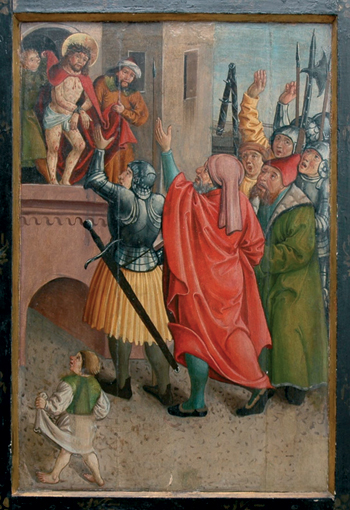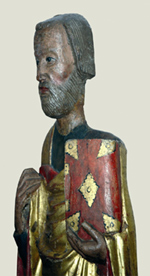The Musée de Normandie, in Caen and the Ensemble Conventuel des Jacobins, in Toulouse, confront the everyday and artistic production of peoples with the aim of making European cultural history better known. The framework in which this exhibition can be shown gives preference to the Middle Ages, a period in which the strong originality of artistic production is expressed through the embellishment of places of worship. It therefore seemed very natural to collaborate with the museum of Eastern Slovakia in Kosice. It was created 130 years ago, when Slovakia was part of the Austrian-Hungarian Empire, but the greater part of its collections were transferred to the Magyar Nemzeti Múzeum in Budapest in 1919. Yet what was kept in Kosice and is presented in Caen and then in Toulouse remains one of the most important collections of sacred art in Eastern Europe
Slovakia today
The territory of Slovakia today, occupied by Slave tribes as of the VIth century, was the heart of the kingdom of Greater Moravia in the IXth century, which included the current Czech Republic and certain regions of Poland, Hungary and Germany. During the next century the kingdom could not push back the Hungarian expansion and the country integrated Hungary for nine centuries.
From the Middle Ages to the Baroque period
As the extreme tip of the Catholic advance in Orthodox territory, Slovakia saw its artistic production flourish during the last two centuries of the Middle Ages. The royal power encouraged the settlement of German, Batavian and Italian immigrants, to exploit the gold and copper mines. It was through architecture, and in particular sacred architecture, that the Gothic style penetrated the territory. On the other hand, the Renaissance, marked by wars, Turkish invasions and the revolt against the Habsburgs, left very few traces. Towards 1650 Baroque art, a revolutionary style, appeared, imposed by the artists who came from Italy and Austria. The local workshops slowly converted and created an important quantity of altars and sculpted works to decorate churches and monasteries. Artistic activity moved further East, in particular towards Kosice.
The itinerary of the exhibition
It presents some fifty major works from the most ancient cathedrals, convents and churches in Eastern Slovakia. They are all in wood (lime, yew), the closest material to find in a wooded environment. The exhibition opens with the oldest altarpiece kept in its entirety in Slovakia, a treasure from the church of Siba that represents saints Cosmas and Damian (end of the XIVth century). After polychrome and golden sculptures, the wooden panels from a polyptych impress all viewers with painted scenes (Annunciation, Resurrection of Lazarus, the prophet Isaac). The Western public will just discover these testimonies by stateless church painters who covered the center of Europe after being trained in Germany or Italy. The theme of the Virgin and Child, repeated over the centuries of the Middle Ages, can be found in monumental sculptures as well as in the modest wooden churches immersed in the endless forests. Church furniture allowed for remarkable productions such as these huge stalls in painted wood, decorated with vegetable and geometric motifs.
Focusing on Kosice
A complete section is reserved for Kosice, the capital of Eastern Slovakia, founded in the XIth century, and its cathedral Saint-Elisabeth, the Gothic construction most to the East in Europe. One discovers objects, images and multimedia that introduce the visitor to the city and then to its main monuments, such as the church of the Dominicans or the former prison. The two legendary kings of Hungary, Saint Stephen and Saint Ladislas stand majestically as two large, polychrome statues from the XVth century, breast-plated, holding their scepter and crown and wearing a cloth coat. They are most probably from the cathedral of Kosice, and are considered as the perfect illustration of Hungarian influence in the region. The «Baroquisation» of churches happened very brutally towards 1650 when political events had put Eastern Slovakia far from the rest of Europe. This phenomenon is illustrated by some masterpieces of Slovak art such as a wooden altar decorated with an incredible
representation of the famous episode of Daniel in the lions' den.
Illustration: Apostle, polychrom wood statue, Ondrej, ca 1380 .Kosice Oriental Slovaquia museum
To see more illustrations, click on VERSION FRANCAISE at the top of this page
|









